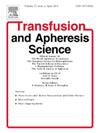血浆置换可以改善治疗抵抗性良性复发性肝内胆汁淤积症患者的临床结果:1例报告
IF 1.2
4区 医学
Q4 HEMATOLOGY
引用次数: 0
摘要
背景:由于良性复发性肝内胆汁淤积(BRIC)的罕见性,关于血浆置换的治疗益处的文献有限,特别是在严重高胆红素血症的情况下。病例报告:一名25岁女性,表现为黄疸和严重瘙痒。实验室结果显示总胆红素37 mg/dL和直接胆红素27 mg/dL。谷丙转氨酶(ALT) 31 U/L,天冬氨酸转氨酶(AST) 35 U/L,碱性磷酸酶175 U/L。患者有5年复发病史,既往自行消退或经药物治疗。在肝活检诊断和常规治疗失败后,她隔天接受血浆置换。使用白蛋白的四次血浆容量交换与药物治疗同时进行。患者表现出瘙痒和尿色的快速和显著改善,无不良事件或需要新鲜冷冻血浆。总胆红素逐渐下降到5 mg/dL,直接胆红素下降到4 mg/dL。结论血浆置换是治疗顽固性BRIC的一种有益的辅助治疗方法,可有效降低胆红素水平,减轻瘙痒。这种干预可能改善患者的生活质量,并可能预防与高胆红素血症相关的肾脏并发症,如有必要,可作为肝移植的桥梁。本文章由计算机程序翻译,如有差异,请以英文原文为准。
Plasmapheresis can improve clinical outcomes in patients with therapy resistant benign recurrent intrahepatic cholestasis: A case report
Background
Due to the rarity of benign recurrent intrahepatic cholestasis (BRIC), limited literature exists regarding the therapeutic benefit of plasmapheresis, particularly in the context of severe hyperbilirubinemia.
Case report
A 25-year-old female presented with jaundice and severe pruritus. Laboratory findings revealed a total bilirubin of 37 mg/dL and a direct bilirubin of 27 mg/dL. Alanine aminotransferase (ALT) was 31 U/L, aspartate aminotransferase (AST) was 35 U/L, and alkaline phosphatase was 175 U/L. The patient had a five-year history of recurrent episodes, previously resolving spontaneously or with medical treatment. Following liver biopsy diagnosis and failure of conventional therapy, she underwent plasmapheresis on alternate days. Four sessions of one plasma volume exchange, using albumin, were performed concurrently with medical treatment. The patient demonstrated rapid and significant improvement in pruritus and urine color, with no adverse events or need for fresh frozen plasma. Total bilirubin decreased progressively to 5 mg/dL, and direct bilirubin to 4 mg/dL.
Conclusion
Plasmapheresis appears to be a beneficial adjunct therapy for refractory BRIC, effectively reducing bilirubin levels and alleviating pruritus. This intervention may improve patient quality of life and potentially prevent renal complications associated with hyperbilirubinemia, serving as a bridge to liver transplantation, if necessary.
求助全文
通过发布文献求助,成功后即可免费获取论文全文。
去求助
来源期刊
CiteScore
3.60
自引率
5.30%
发文量
181
审稿时长
42 days
期刊介绍:
Transfusion and Apheresis Science brings comprehensive and up-to-date information to physicians and health care professionals involved in the rapidly changing fields of transfusion medicine, hemostasis and apheresis. The journal presents original articles relating to scientific and clinical studies in the areas of immunohematology, transfusion practice, bleeding and thrombotic disorders and both therapeutic and donor apheresis including hematopoietic stem cells. Topics covered include the collection and processing of blood, compatibility testing and guidelines for the use of blood products, as well as screening for and transmission of blood-borne diseases. All areas of apheresis - therapeutic and collection - are also addressed. We would like to specifically encourage allied health professionals in this area to submit manuscripts that relate to improved patient and donor care, technical aspects and educational issues.
Transfusion and Apheresis Science features a "Theme" section which includes, in each issue, a group of papers designed to review a specific topic of current importance in transfusion and hemostasis for the discussion of topical issues specific to apheresis and focuses on the operators'' viewpoint. Another section is "What''s Happening" which provides informal reporting of activities in the field. In addition, brief case reports and Letters to the Editor, as well as reviews of meetings and events of general interest, and a listing of recent patents make the journal a complete source of information for practitioners of transfusion, hemostasis and apheresis science. Immediate dissemination of important information is ensured by the commitment of Transfusion and Apheresis Science to rapid publication of both symposia and submitted papers.

 求助内容:
求助内容: 应助结果提醒方式:
应助结果提醒方式:


